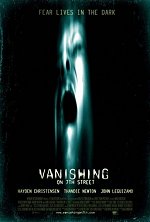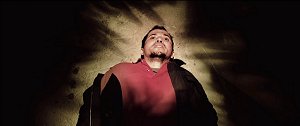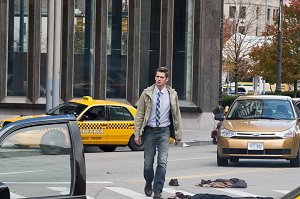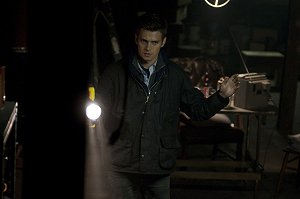 |
|
At The Picture Show
|
May 2011
Darkness falls
'Vanishing on 7th Street' makes a palpable foe out of a primal fear

Vanishing on 7th Street
Magnet Releasing
Director: Brad Anderson
Screenplay: Anthony Jaswinski
Starring: Hayden Christensen, Thandie Newton, John Leguizamo and Jacob Latimore
Rated R / 1 hour, 32 minutes
Now playing in limited release and VOD


 (out of four)
(out of four)
Sometimes all it takes is one great character, one great performance. The kind of character whose
very presence is imprinted on the entire film. The kind of performance without which everything
else would fall apart.
The darkness in Vanishing on 7th Street is one such character. And make no mistake, it is a
character.
 To take something intangible and transform it into a living,
breathing character is a unique accomplishment. It can be a place (the city of New Orleans in
HBO's Treme) or even a song ("California Dreamin'" in Wong Kar Wai's Chungking Express);
in this case it's merely a shadow cast across (presumably) the globe, the villain and perpetrator
of a surreal apocalypse.
To take something intangible and transform it into a living,
breathing character is a unique accomplishment. It can be a place (the city of New Orleans in
HBO's Treme) or even a song ("California Dreamin'" in Wong Kar Wai's Chungking Express);
in this case it's merely a shadow cast across (presumably) the globe, the villain and perpetrator
of a surreal apocalypse.
If there were a gender-neutral Oscar category for supporting performance, this would make a
worthy candidate. The "performers," per se, would be the lighting and special effects, which
director Brad Anderson uses to create a truly menacing figure - its body contorting and winding
itself around every source of light, its arms predatorily stretching for its next victim, its shadow
lurking behind like a stalker.
We see so many lackluster antagonists (human or otherwise) who might as well be lifeless and
faceless, yet here we have a villain that is both of those - is, in a sense, invisible - and it feels
palpable. Physical, even. As if, for once, there's actually something (someone?) to be afraid of,
to fight against.
Using the formula of the lawless postapocalyptic thriller, Vanishing taps into that most elemental
of human fears - the fear of the dark. Anderson and screenwriter Anthony Jaswinski never feel
compelled to delve beyond that. The darkness remains a singular and ambiguous force whose
silent destruction resists any and all explanation.
 The apocalypse is as abrupt as it is unexplained. The power
goes out in a movie theatre and within moments everyone has disappeared, their clothes lying
harmlessly in a heap on the ground. (Whether this means there are legions of naked people
running around in some sort of metaphysical netherworld is a story for another time. Perhaps the
sequel.)
The apocalypse is as abrupt as it is unexplained. The power
goes out in a movie theatre and within moments everyone has disappeared, their clothes lying
harmlessly in a heap on the ground. (Whether this means there are legions of naked people
running around in some sort of metaphysical netherworld is a story for another time. Perhaps the
sequel.)
The streets and sidewalks are virtually empty the next morning, stopped cars strewn about,
electricity all but dead, in a Twilight Zone-esque image of eerie, deathly calm. The film never
gets beyond the borders of its Detroit setting, but the implication - that this is worldwide - is
clear. Those who survived the initial purge did so quite by accident - simply by being in the
presence of light of some kind (a laptop screen, a flashlight, etc.), a light that granted them at
least a temporary respite from what seems like an inevitable fate.
As postapocalyptic tales so often do, Vanishing sets up shop in a centralized location with a
small group of survivors - in this case Luke (Hayden Christensen), a local news anchor whose
barrage of dangling lights hanging from his raincoat protects him even at the darkest of night;
Paul (John Leguizamo), a movie projectionist; Rosemary (Thandie Newton), a nurse desperate to
find her missing child; and James (Jacob Latimore), a 12-year-old boy who has taken refuge in
an old-fashioned tavern whose generator has kept the lights on, at least for the time being.
With the amount of sunlight growing shorter by the day, sources of light get more and more
scarce and the odds of everyone (or anyone) surviving dwindles. While the screenplay has its
problems, it deserves credit for not getting itself stuck in place. The characters, like the film, are
resourceful, continually finding ways to buy as much time as they can, even if it's only another
few hours.
 It's refreshing to see a horror film built on some of the most
basic fundamentals of horror - i.e. the emphasis on mood over spectacle, suggestion over action.
And what is more fundamental to horror's roots than shadow itself? The most famous shot of the
greatest horror film of all-time, F.W. Murnau's Nosferatu, is not of the vampire himself, but of
his silhouette cast against a staircase wall.
It's refreshing to see a horror film built on some of the most
basic fundamentals of horror - i.e. the emphasis on mood over spectacle, suggestion over action.
And what is more fundamental to horror's roots than shadow itself? The most famous shot of the
greatest horror film of all-time, F.W. Murnau's Nosferatu, is not of the vampire himself, but of
his silhouette cast against a staircase wall.
Vanishing on 7th Street very well could have been a black-and-white film if it had wanted to be,
and the premise would have worked as well (if not better) in the silent era as it does today.
Continued Below Advertisement
Read more by Chris Bellamy